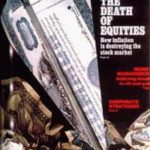Special to the Financial Independence Hub
Legend has it, 19thcentury humorist Mark Twain once had to refute a rash of rumors swirling in the popular press about his alleged death. “The report of my death was an exaggeration,” he wryly observed.
What about the stock market: how many times have popular pundits pronounced its demise? Clearly, all such predictions have been dead wrong so far.
One noteworthy example is a Business Week cover story that ran exactly 40 years ago, on August 13, 1979. Advisor and blogger Barry Ritholtz has reprinted this now-infamous article here, for historical reference. Its authors bemoaned, “this ‘death of equity’ can no longer be seen as something a stock market rally — however strong — will check. It has persisted for more than 10 years …”
My take: This article, and plenty of others like it, are textbook examples of financial pornography. As Ritholtz observed in a separate piece, “One day, the world will indeed end. The sun will run out of hydrogen fuel, turn into a red giant star, and expand until it engulfs the earth. That is about 5 billion years in the future. In the meantime, you can safely ignore all other forecasts.”
I couldn’t agree more, at least when it comes to market forecasts. There’s always something causing us to wonder whether the end is near. A few years ago, it was Greece. Now there’s trade wars.
Return-dampening concerns
These too shall pass, only to be replaced by new sources of return-dampening concern. In the meantime, quietly, unexcitedly (and thus often without remark), the markets will almost certainly continue to inch upward over time.
Consider that 40 years is probably most peoples’ investment horizon. As an exercise, I pulled some returns from various indexes, in Canadian dollars. Since Business Week pronounced the death of equities, here’s what actually happened:
- Inflation grew by 3.12% per year; so something that cost you a $1 in 1979 would roughly cost you $3.40 today, or more than three times as much.
- If you kept your money in Canadian 30-day T-bills (a “risk-free” investment), the annual return was 5.53% per year. In dollar terms, $1 would have grown to $8.58, or more than twice the inflation rate. As an aside, the vast majority of this return came during the high interest rates of the 1980s. Since 2009, the return of 30-day T-bills has been lower than inflation by about 1% per year.
- A basket of diversified global equities returned 9.84% per year; so a $1 investment grew to $42.42. Put another way that is 42 times more than leaving your money in a mattress, which after reading this article might have seemed like a good idea at that time. Not a bad return for something that was supposed to be “dead.”
For my money, I’m continuing to bet that our stock markets will remain alive and well for another 40 years, and then some. Unless the sun actually does explode, in which case, I stand corrected.
 Steve Lowrie holds the CFA designation and has 25 years of experience dealing with individual investors. Before creating Lowrie Financial in 2009, he worked at various Bay Street brokerage firms both as an advisor and in management. “I help investors ignore the Wall and Bay Street hype and hysteria, and focus on what’s best for themselves.” This blog originally appeared on his site on on Aug. 9, 2019 and is republished here with permission.
Steve Lowrie holds the CFA designation and has 25 years of experience dealing with individual investors. Before creating Lowrie Financial in 2009, he worked at various Bay Street brokerage firms both as an advisor and in management. “I help investors ignore the Wall and Bay Street hype and hysteria, and focus on what’s best for themselves.” This blog originally appeared on his site on on Aug. 9, 2019 and is republished here with permission.



